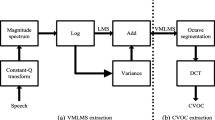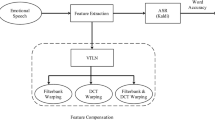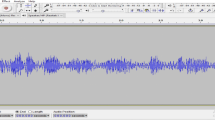Abstract
Speech is one of the important modalities in a serious game platform. Serious game can be very useful for the rehabilitation of individuals with voice disorders. Therefore, we need an efficient and high-performance automatic speech recognition (ASR) system. In this paper, we propose a spectro-temporal directional derivative (STDD) feature that requires less number of computations in the modeling and yet gives high recognition accuracy in the ASR system. The proposed STDD feature is achieved by applying different directional derivative filters in the spectro-temporal domain. The feature dimension is then compressed by discrete cosine transform. The experiments are performed with voice samples of Arabic numerals spoken by persons with and without voice pathology. The experimental results show that the STDD feature outperforms the conventional mel-frequency cepstral coefficients both in clean and noisy environments.







Similar content being viewed by others
References
Abe S (2005) Support vector machines for pattern classification. Springer, Berlin
Abt CC (1970) Serious games. Viking Press, New York, p 9
Arias-Londoño JD, Godino-Llorente JI, Sáenz-Lechón N, Osma-Ruiz V (2010) An improved method for voice pathology detection by means of a HMM-based feature space transformation. J Pattern Recog 43(9):3100–3112
Atal BS (1974) Effectiveness of linear prediction characteristics of the speech wave for automatic speaker identification and recognition. J Acoust Soc Am 54(6):1304–1312
Barab S, Thomas M, Dodge T, Carteaux R, Tuzun H (2005) Making learning fun: quest Atlantis a game without guns. Educ Technol Res Dev 53:86–107
Batliner A, Steidi S, Hacker C, Noth E (2008) Private emotions versus social interaction: a data-driven approach towards analyzing emotion in speech. User Model User-Adap Inter 18:175–206
Bergeron B (2008) Learning and retention in adaptive serious games. Stud Health Technol Inf 132:26–30
Botella C, Villa H, Garcia P, Quero S, Banos R, Alcaniz M (2004) The use of VR in the treatment of panic disorders and agoraphobia. Stud Health Technol Inf 99:73–90
Boyanov B, Hadjitodorov S (1997) Acoustic analysis of pathological voices. IEEE Eng Med Biol Mag 16:74–82
Costa SC, Aguiar Neto BG, Fechine JM (2008) Pathological voice discrimination using cepstral analysis, vector quantization and hidden Markov models. Proceedings of 8th IEEE International Conference on BioInformatics and BioEngineering, BIBE, pp. 1–5
Cowie R, Douglas-Cowie E, Tsapatsoulis N et al (2001) Emotion recognition in human-computer interaction. IEEE Signal Process Mag 18:32–80
Dibazar AA, Narayanan S, Berger TW (2002) Feature analysis for automatic detection of pathological speech. Proceedings of 2nd Joint Conference of EMBS/BMES, vol. 1, Houston, TX, USA
Duda RO, Hart PE, Strork HG (2000) Pattern classification. Wiley-Interscience, NY
Fernandez-Aranda F, Jimenez-Murcia S, Santamaria JJ et al (2012) Video games as a complementary therapy tool in mental disorders: PlayMancer, a European multicentre study. J Ment Health 21(4):364–374
Godino-Llorente JI, Gomez-Vilda P (2004) Automatic detection of voice impairments by means of short-term cepstral parameters and neural network based detectors. IEEE Trans Biomed Eng 51:380–384
Godino-Llorente JI, Fraile R, Saenz-Lechon N, Osma-Ruiz V, Gomez-Vilda P (2009) Automatic detection of voice impairments from text-dependent running speech. Biomed Sig Process Control 4:176–182
Hadjitodorov S, Boyanov B, Teston B (2000) Laryngeal pathology detection by means of class-specific neural maps. IEEE Trans Inf Technol Biomed 4:68–73
Marinaki M, Kotropoulos C, Pitas I, MaglaverasN (2004) Automatic detection of vocal fold paralysis and edema. Proceedings of ICSLP’04, Jeju Island, South Korea
Markaki M, Stylianou Y (2011) Voice pathology detection and discrimination based on modulation spectral features. IEEE Trans Audio Speech Lang Process 19(7):1938–1948
Moore BCJ (1997) An introduction to the psychology of hearing, 4th edn. Academic Press, London
Muhammad G, Melhem M (2014) Voice pathology detection and binary classification using MPEG-7 audio features. Biomed Sig Process Controls. doi:10.1016/j.bspc.2014.02.001
Muhammad G, Mesallam TA, Malki KH, Farahat M, Alsulaiman M, Bukhari M (2011) Formant analysis in dysphonic patients and automatic Arabic digit speech recognition. Biomed Eng Online 10:41
Muhammad G, Mesallam TA, Almalki KH, Farahat M, Mahmood A, Alsulaiman M (2012) Multi Directional Regression (MDR) based features for automatic voice disorder detection. J Voice Elsevier 26(6):817.e19–817.e27. doi:10.1016/j.jvoice.2012.05.002
Rabiner L, Juang BH (1993) Fundamentals of speech recognition. Prentice-Hall, Englewood Cliffs
Santamaria JJ, Soto A, Fernandez-Aranda F, Krug I, Forcano L, Kalapanidas E, Gunnard K, Lam T, Raguin T, Davarakis C, Menchon JM, Jimenez-Murcia S (2011) Serious games as additional psychological support: a review of the literature. Cyberpsychol Behav Ther 4:469–476
Schuller B, Steidl S, Batliner A (2010) The Interspeech 2010 Paralinguistic Challenge. Proc. Interspeech 2010, pp. 2794–2797
Acknowledgments
The authors extend their appreciation to the Deanship of Scientific Research at King Saud University, Riyadh, Saudi Arabia for funding this work through the research group project No RGP-VPP-228.
Author information
Authors and Affiliations
Corresponding author
Rights and permissions
About this article
Cite this article
Muhammad, G., Masud, M., Alelaiwi, A. et al. Spectro-temporal directional derivative based automatic speech recognition for a serious game scenario. Multimed Tools Appl 74, 5313–5327 (2015). https://doi.org/10.1007/s11042-014-1973-7
Published:
Issue Date:
DOI: https://doi.org/10.1007/s11042-014-1973-7




